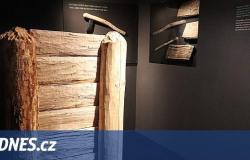The Mount Erebus volcano emits dozens of grams of gold worth over 140 thousand crowns and other valuable metals into the air every day. According to scientists, volcanic activity in Antarctica could also have mining potential, which would provide an almost unlimited source of green energy. They have similar plans elsewhere in the world, including Europe.
Mount Erebus volcano, Ross Island, Antarctica.
| Photo: Wikimedia Commons, NSF/Josh Landis
An active volcano produces gold dust worth up to 140,000 crowns per day Mount Erebus located on Antarctica. According to the IFL Science server, scientists have found that regular jets of gas are full of tiny crystals less than twenty micrometers in size. According to experts’ estimates, the volcano spews out up to eighty grams of gold per day.
The research team also observed that the gold dust continued to spread into the far vicinity. He discovered traces of particles in the atmosphere up to a distance of a thousand kilometers from the volcano.
She paid for the photo with her life. A tourist fell into the crater of an Indonesian volcano
“Mount Erebus has an unusual chemical composition of magma,” volcanologist Tamsin Mather from the University of Oxford explained to the British newspaper Metro. She added that the volcano produces gases throughout the day, as it is one of the few that has a permanently active lava lake in its crater. According to her, it has been bubbling continuously since 1972.
Matherová further specified that people should not think of nuggets known, for example, from finds during California Gold Rush. “They’re just chemical compounds,” she said.
A close-up view of Mount Erebus:
Source: Youtube
Although Mount Erebus has unique magma, the gold spurts are not unique. According to Mather, a similar phenomenon can be observed at many other volcanoes. Together with them, other precious metals, such as copper, are released into the atmosphere.
The Guardian wrote that, for example, Etna in Italy, it releases roughly twenty tons of copper and ten kilograms of gold in gases every day.
Use for green energy
However, mining metals released from volcanoes is difficult, if not impossible. “The problem is that if they were to be pumped out, they would be very diluted,” Mather said. In addition, gas cannot be processed directly above an active volcano.
However, according to experts, the potential could be in the mining of magmatic brines. Superconcentrated metals and hot fluids are stored in them, which can be used to produce geothermal energy. At the same time, the mining process could also be carbon neutral. According to The Guardian, approximately two thousand volcanoes could become brine mines for metals. In Europe, up to fifteen countries would have this resource.
Volcanic magma represents the potential of unlimited green energy:
Source: Youtube
Volcanoes are already used by humans as unlimited sources of green energy. “All over the world, they are used to obtain naturally heated water, or steam from them drives turbines to generate electricity,” Oxford volcanologist David Pyle told Newsweek.
This year on Iceland they also performed the first ever borehole into the magma chamber. Experts hope to use the magma to heat water and generate electricity. If successful, the project could be a turning point for a greener energy future.
A dark volcano marked by disaster
People know Antarctica primarily as a vast frozen continent. Nevertheless, there are dozens of volcanoes on it, several of which are active. Most of them are found in West Antarctica and Marie Byrd Land. According to a 2017 study, there are 138 volcanoes in the areas.
Something is happening beneath the surface of the Earth. After centuries of calm, dangerous forces are awakening
Mount Erebus, reaching a height of 3794 meters, is the highest active volcano in Antarctica and at the same time the southernmost active volcano on Earth. It was named after the Greek god of darkness by explorer James Clark Ross, who first saw it in 1841 during an eruption.
The volcano is infamous tragedy of 1979, when a plane crashed into it during Air New Zealand sightseeing flight 901. All 257 people on board died in the accident. The BBC recalled that at the scene of the wreck, explorers found cameras with photos taken just before the impact. After legal disputes with the families of the survivors, a New Zealand company has ended tourist trips over Antarctica.
Tags: volcano Antarctica spews gold spewing tens thousands crowns day catch
-






